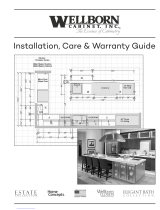
2
Table of Contents
Safety Information ..................................2
Warranty ..........................................2
Pre-Installation .....................................3
Planning Installation ...............................3
To avoid cracking and splitting of wood: ................3
Tools Required ....................................4
Installation ........................................5
Maintenance .......................................8
Protecting the Surface ..............................8
Care and Cleaning ..................................8
Food Contact Considerations .........................8
Removing a Dent from your Top .......................9
Safety Information
Read and understand these instructions before installation of this
countertop.
Save these instructions for future reference.
MINNESOTA RESIDENTS
IMPORTANT HEALTH NOTICE.
SOME OF THE BUILDING MATERIALS USED IN THIS HOME (OR THESE)
BUILDING MATERIALS EMIT FORMALDEHYDE. EYE, NOSE, AND
THROAT IRRITATION, HEADACHE, NAUSEA AND A VARIETY OF ASTHMA-
LIKE SYMPTOMS, INCLUDING SHORTNESS OF BREATH, HAVE BEEN
REPORTED AS A RESULT OF FORMALDEHYDE EXPOSURE. ELDERLY
PERSONS AND YOUNG CHILDREN, AS WELL AS ANYONE WITH A
HISTORY OF ASTHMA, ALLERGIES, OR LUNG PROBLEMS, MAY BE AT
GREATER RISK. RESEARCH IS CONTINUING ON THE POSSIBLE LONG-
TERM EFFECTS OF EXPOSURE TO FORMALDEHYDE.
REDUCED VENTILATION MAY ALLOW FORMALDEHYDE AND OTHER
CONTAMINANTS TO ACCUMULATE IN THE INDOOR AIR. HIGH INDOOR
TEMPERATURES AND HUMIDITY RAISE FORMALDEHYDE LEVELS.
WHEN A HOME IS TO BE LOCATED IN AREAS SUBJECT TO EXTREME
SUMMER TEMPERATURES, AN AIR CONDITIONING SYSTEM CAN BE
USED TO CONTROL INDOOR TEMPERATURE LEVELS. OTHER MEANS OF
CONTROLLED MECHANICAL VENTILATION CAN BE USED TO REDUCE
LEVELS OF FORMALDEHYDE AND OTHER INDOOR AIR CONTAMINANTS.
IF YOU HAVE ANY QUESTIONS REGARDING THE HEALTH EFFECTS
OF FORMALDEHYDE, CONSULT YOUR DOCTOR OR LOCAL HEALTH
DEPARTMENT.
WARNING: Apply caution when using power tools.
CALIFORNIA RESIDENTS
WARNING: This product can expose you to chemicals
including formaldehyde (gas), which is [are] known to the
State of California to cause cancer. For more information go
to www.P65Warnings.ca.gov/products.
Warranty
Contact the Customer Service Team at 1-855-HD-HAMPTON or visit www.HAMPTONBAY.com.




















